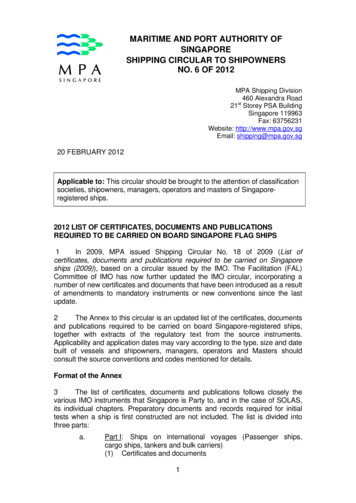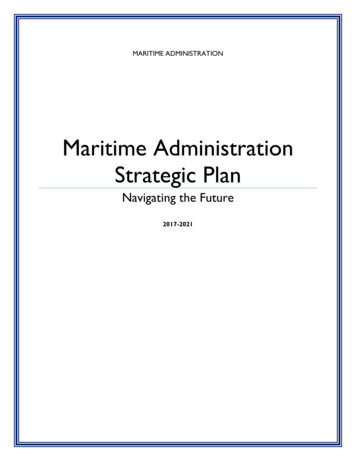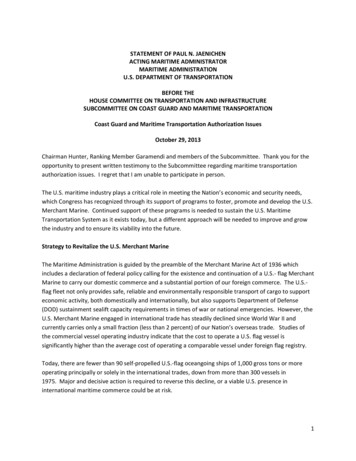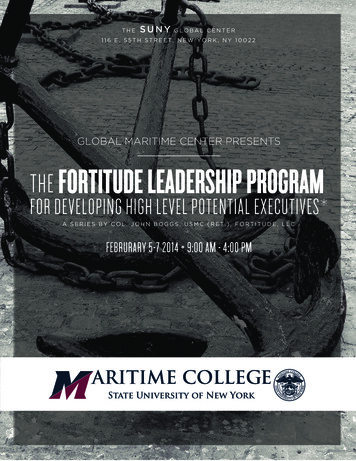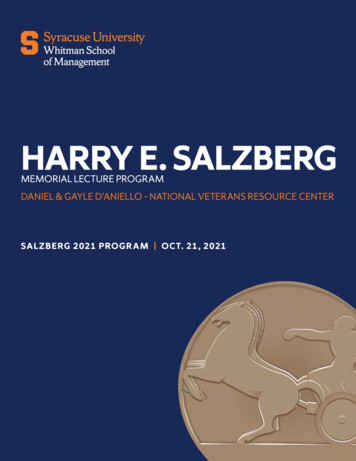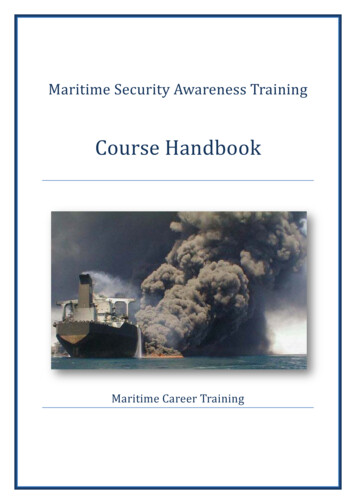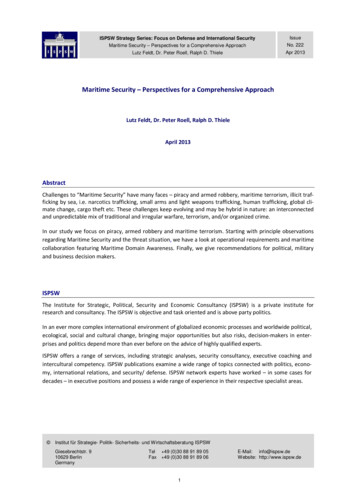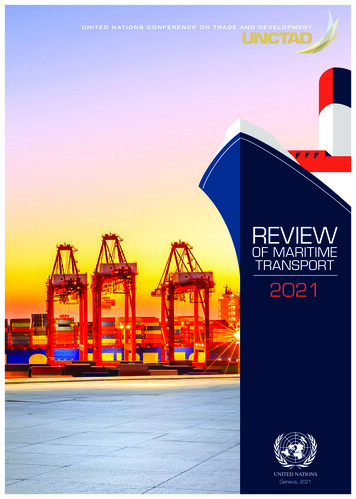
Transcription
U N I T E D N AT I O N S C O N F E R E N C E O N T R A D E A N D D E V E L O P M E N TREVIEWOF MARITIMETRANSPORT2021Geneva, 2021
REVIEW OF MARITIME TRANSPORT 2021 2021, United NationsAll rights reserved worldwideRequests to reproduce excerpts or to photocopy should be addressed to the Copyright Clearance Centreat copyright.com.All other queries on rights and licences, including subsidiary rights, should be addressed to:United Nations Publications405 East 42nd Street, New York, New York10017 United States of AmericaEmail: publications@un.orgWebsite: https://shop.un.orgThe designations employed and the presentation of material on any map in this work do not imply theexpression of any opinion whatsoever on the part of the United Nations concerning the legal status ofany country, territory, city or area or of its authorities, or concerning the delimitation of its frontiers orboundaries.Mention of any firm or licensed process does not imply the endorsement of the United Nations.This publication has been edited externally.United Nations publication issued by the United Nations Conference on Trade and Development.UNCTAD/RMT/2021ISBN: 978-92-1-113026-3eISBN: 978-92-1-000097-0ISSN: 0566-7682eISSN: 2225-3459Sales No. E.21.II.D.21ii
REVIEW OF MARITIME TRANSPORT 2021AcknowledgementsThe Review of Maritime Transport 2021 was prepared by UNCTAD under the overall guidance of ShamikaN. Sirimanne, Director of the Division on Technology and Logistics of UNCTAD, and under the coordinationof Jan Hoffmann, Head of the Trade Logistics Branch, Division on Technology and Logistics. ReginaAsariotis, Gonzalo Ayala, Mark Assaf, Celine Bacrot, Hassiba Benamara, Dominique Chantrel, AmélieCournoyer, Marco Fugazza, Poul Hansen, Jan Hoffmann, Tomasz Kulaga, Anila Premti, Luisa Rodríguez,Benny Salo, Kamal Tahiri, Hidenobu Tokuda, Pamela Ugaz and Frida Youssef were contributing authors.The report benefitted from reviews and contributions by officials from the International MaritimeOrganization, the International Labour Organization partners of the TrainForTrade Port ManagementProgramme and the five regional commissions of the United Nations (ECA, ECE, ECLAC, ESCAP, andESCWA): Julian Abril Garcia, Peter Adams, Mario Apostolov, Yarob Badr, Jan de Boer, Aicha Cherif,Ismael Cobos Delgado, Yann Duval, Martina Fontanet Solé, Fouad Ghorra, Fredrik Haag, Robert Lisinge,Dorota Lost-Sieminska, Ricardo Sanchez, Lynn Tan, Lukasz Wyrowski and Brandt Wagner.Comments and suggestions from the following reviewers are gratefully acknowledged: Hashim AbbasSyed, Roar Adland, Stefanos Alexopoulos, Jason Angelopoulos, Tracy Chatman, Trevor Crowe, NeilDavidson, Juan Manuel Díez Orejas, Mahin Faghfouri, Mike Garrat, Nadia Hasham, Joe Hiney, JulianHoffmann Anton, Onno Hoffmeister, Roel Janssens, Lars Jensen, Björn Klippel, Eleni Kontou, JuanManuel, Antonis Michail, Turloch Mooney, Richard Morton, Plamen Natzkoff, Jean-Paul Rodrigue, PeterSand, Torbjorn Rydbergh, Alastair Stevenson, Stelios Stratidakis, Christa Sys, Antonella Teodoro andRuosi Zhang. Experts from the International Chamber of Shipping reviewed chapter 2.Comments received from UNCTAD divisions as part of the internal peer review process, as well ascomments from the Office of the Secretary-General, are acknowledged with appreciation.The Review was edited by Peter Stalker. Administrative, editing, and proofreading support was providedby Wendy Juan. Magali Studer designed the publication, and Juan Carlos Korol did the formatting.Special thanks are also due to Vladislav Shuvalov for reviewing the publication in full.iii
REVIEW OF MARITIME TRANSPORT 2021TABLE OF iiOverview.xiv1.2.3.International maritime trade and port traffic. 1A.Volumes of international maritime trade and port traffic. 3B.Outlook and longer-term trends. 19C.Policy considerations and action areas. 23Maritime transport and infrastructure. 29A.The world fleet. 31B.Shipping companies and operations: adapting maritime transport supplyin an uncertain environment . 42C.Port services and infrastructure supply. 46D.The Impact of COVID-19 on ports: lessons from the UNCTAD TrainForTrade PortManagement Programme . 49E.Summary and policy considerations. 54Freight rates, maritime transport costs and their impact on prices. 57A.Record-breaking container freight rates . 59B.Dry bulk freight rates also reach highs. 64C.Tanker freight rates dip to the lowest levels ever . 65D.Economic impact of high container freight rates, particularly in smaller countries. 66E.Structural determinants of maritime transport costs. 70F.Summary and policy considerations. 74Technical Notes. 784.5.6.Key performance indicators for ports and the shipping fleet. 87A.Port calls and turnaround times. 89B.Liner shipping connectivity. 93C.Port cargo handling performance . 99E.Greenhouse gas emissions by the world fleet. 105F.Summary and policy considerations. 106The COVID-19 seafarer crisis. 109A.Seafarers crisis – recent developments . 111B.Seafarer crisis – implementation of the ILO Maritime Labour Convention, 2006,as amended (MLC 2006). 115C.Crew changes and key worker status – other relevant international legal instruments. 117D.The way forward. 119Legal and regulatory developments and the facilitationof maritime trade . 125A.Technological developments in the maritime industry . 127B.Regulatory developments relating to international shipping, climate changeand other environmental issues. 128C.Legal and regulatory implications of the COVID-19 pandemic. 133D.Other legal and regulatory developments affecting transportation. 133E.Maritime transport within the WTO Trade Facilitation Agreement . 135F.FAL Convention . 139G.ASYCUDA ASYHUB case studies . 141H.Summary and policy considerations. 142iv
REVIEW OF MARITIME TRANSPORT 2021Tables1World fleet by principal vessel type, 2020–2021. xvi2Five largest seafarer-supplying countries 2021 supplying countries 2021. xx1.1International maritime trade, 1970–2020.31.2International maritime trade 2019–2020, by type of cargo, country group and region.41.3World economic growth, 2019–2021.61.4Growth in the volume of world merchandise trade, 2019–2021.71.5Tanker trade, 2019–2020.111.6Dry bulk trade 2019–2020.121.7Major dry bulk and steel: producers, users, exporters, and importers, 2020.131.8Containerized trade on East-West trade routes, 2016–2020.151.9Containerized trade on major East-West trade routes, 2014–2021.151.10World container port throughput by region, 2019–2020.171.11International maritime trade developments forecasts, 2021–2026.192.1World fleet by principal vessel type, 2020–2021.312.2Age distribution of world merchant fleet by vessel type, 2021and average age 2020–2021.322.3Top 25 ship-owning economies, as of 1 January 2021.352.4Ownership of the world fleet, ranked by carrying capacity in dead-weight tons, 2021.362.5Leading flags of registration by dead-weight tonnage, 2021.382.6Leading flags of registration, ranked by value of total tonnage, 2021 (million US dollars)and principal vessel types.392.7Deliveries of newbuildings by major vessel types and countries of construction, 2020.392.8Reported tonnage sold for ship recycling by major vessel typeand country of ship recycling, 2020.412.9Status of uptake of selected technologies in global shipping, as of 14 June 2021.422.10Some proposed IMO measures to reduce greenhouse gas emissions.432.11World fleet by fuel type as of 1 January 2021.452.12Industrial port projects capitalizing on green opportunities to generatenew revenue streams.482.13Factors affecting the development of smart green ports.492.14Port Performance Scorecard indicators, 2016–2020.503.1Contract freight rates, inter-regional, 2018–2020, per 40-foot container.624.1Time in port, age, and vessel sizes, by vessel type, 2020, world total.904.2Port calls and median time spent in port, container ships, 2020, top 25 countries.914.3Top 25 ports under the World Bank IHS Markit Container Port Performance Index 2020.994.4Minutes per container move, by range of call size, top 25 countries by port calls.1014.5Cargo and vessel handling performance for dry bulk carriers. Top 30 economiesby vessel arrivals, average values for 2018 to first half of 2021.1034.6Cargo and vessel handling performance for tankers. Top 30 countriesby vessel arrivals, average values for 2018 to first half of 2021.1045.1Neptune Declaration Crew Change Indicator, July 2021.1135.2Five largest seafarer-supply countries, 2021.1156.1Key performance indicators of the Kenya Trade Information Portal.138v
REVIEW OF MARITIME TRANSPORT 2021Figures1International maritime trade, world gross domestic product (GDP)and maritime trade-to-GDP ratio, 2006 to 2021. xii2Simulated impact of current container freight rate surge on importand consumer price levels. xv3Median time in port, number of port calls, and maximum vessel sizes,by country, container ships, 2020.xvii1.1International maritime trade, world gross domestic product (GDP)and maritime trade-to-GDP ratio, 2006 to 2021.51.2Participation of developing countries in international maritime trade, selected years.51.3International maritime trade, by region, 2020.51.4International maritime trade by cargo type, selected years.81.5International maritime trade in cargo ton-miles, 2001–2021.91.6World capesize dry bulk trade by exporting region in tons and ton-miles, 2019–2020.101.7World ultra-large tanker trade by exporting region in ton and ton-miles , 2018–2020.101.8Global containerized trade, 1996–2021.141.9Global containerized trade by route, 2020.141.10World container port throughput by region, 2019–2020.181.11Leading 20 global container ports, 2019–2020.182.1Annual growth rate of world fleet, dead-weight tonnage, 2000–2020.312.2Age distribution of the global fleet, share of the global carrying capacity, 2012–2021.332.3Age distribution of the fleet, as at beginning of 2021, per development status groups.332.4Share of mega-vessels in the global container ship fleet carrying capacityby TEU, 2011–2021.342.5Number of mega-containerships.342.6Mega-vessel distinct journeys through the Panama and Suez canals,daily averages, from 2012 until 4 June 2021.342.7Live and on-order global fleet by ship type.372.8Growth of world fleet orderbook, 2012–2021, percentage changein dead-weight tonnage.402.9World tonnage on order, selected ship types, 2000–2021.412.10Percentage change in cost intensity by ship segment, average sizeand median distance travelled.442.11Cargo and revenue, 2016–2020.512.12Average revenue mix of ports, 2016–2020.523.1Growth of demand and supply in container shipping, 2007–2021, percentage.593.2CCFI composite index, 2011-2021 (quarterly).603.3Shanghai Containerized Freight Index weekly spot rates, 1 July 2011 to 30 July 2021,selected routes .603.4New ConTex index, July 2011–July 2021.633.5Baltic Exchange Dry Index, January 2010–July 2021.653.6Average weighted earnings all bulkers ( /day), July 2001–July 2021.653.7Average earnings, all tankers, July 2011–July 2021.663.8Simulated impact of current container freight rate surge on importand consumer price levels.67vi
REVIEW OF MARITIME TRANSPORT 20213.9Simulated impacts of the container freight rate surge on consumer price levels,by country and by product.683.10Simulated impacts of container freight rate surges on prices for importers,consumers and firms, global average.693.11Simulated impact of container freight rate surges on production costs,by country and size of economy.693.12Simulated dynamic impacts of container freight rate increase on industrial production.703.13Transport costs for importing goods by transport mode, world, LDCs,and LLDCs, 2016, percentage of FOB value.713.14Transport costs heatmap for importing goods, all modes of transport, 2016,percentage of FOB value.713.15Maritime transport costs for importing goods and distances from trading partners.723.16Maritime transport costs for importing goods, by country and size of economy.733.17Impact of structural determinants on maritime transport costs for importing goods.733.18Maritime transport costs by direction of the trade imbalance.743.19Impacts of trade imbalance and trade volume on maritime transport costs.744.1Port calls per half year, world total, 2018–2020.894.2Port calls per half year, regional totals, 2018–2020.894.3Container ship port calls and time in port, 2020.904.4Container ship port calls and maximum ship sizes, 2020.914.5Container ship port calls in Africa and time in port, 2020.924.6Container ship port calls in Africa and maximum ship sizes, 2020.924.7Median time in port, number of port calls, and maximum vessel sizes, per country,container ships, 2020.924.8Liner shipping connectivity index, top 10 countries, first quarter 2006to second quarter 2021.934.9Port Liner Shipping Connectivity Index, top 10 ports as of second quarter 2021,first quarter 2006 to second quarter 2021.944.10Liner Shipping Connectivity Index, country and port level, 2020.954.11Trends in global container ship deployment, first quarter 2006 to second quarter 2021.964.12Trends in vessel sizes and number of companies providing services,selected countries, first quarter 2006 to second quarter 2021.974.13Relationship between maximum vessel sizes, deployed capacity, and the numberof companies, second quarter 2021.984.14Liner Shipping Bilateral Connectivity Index (LSBCI) and its components,first quarter 2006 to second quarter 2021.994.15Minutes per container move for container ships, by range of port call size.1004.16Time in port (hours) for container ships, by range of port call size.1004.17Correlation between time in port (hours) and minutes per container move, all call sizes.1014.18Correlation between time in port (hours) and minutes per container move,only calls with 1001 to 1500 containers per call.1014.19Carbon dioxide emissions by vessel type, monthly, million tons, 2011–2021.1054.20Carbon dioxide emissions by flag state, annual, 2011–2020, million tons.106vii
REVIEW OF MARITIME TRANSPORT 2021Boxes1Implications of AfCFTA for maritime transport in Africa.202.1Divided views on whether oil should be replaced by LNG.462.2Building port resilience UNCTAD experience.462.3Guidance and standards for intermodal operations.472.4Port performance analysis of the Port of Gijon in 2020.512.5Port performance analysis of the national port system in Peru in 2020.522.6Gender and development in the Philippine Ports Authority and its journey.533.1Impact of COVID-19 on maritime freight rates in the Arab region.614.1Port performance in Latin America and the Caribbean – differences betweentypes of terminals.1025.1The case of the Philippines.1146.1The Framework Agreement on Facilitation of Cross-Border Paperless Trade in Asiaand the Pacific - Maritime implications.1386.2IMO Compendium on Facilitation and Electronic Business.1396.3Components of the Digitizing Global Maritime Trade project .1416.4Customs formalities concerning entry or exit .142viii
REVIEW OF MARITIME TRANSPORT 2021ABBREVIATIONSAfCFTAAfrican Continental Free Trade AreaAGTCEuropean Agreement on Important International Combined Transport LinesAPECAsia-Pacific Economic CooperationASYCUDAASYHUBAutomated System for Customs DataASYCUDA data integration systemB2Bbusiness to businessB2Gbusiness to governmentBIMCOBaltic and International Maritime CouncilCAPEXcapital expenditureCCFIChina Containerized Freight IndexCIFcost, insurance and freightCIICarbon Intensity IndicatorCO2CPPIDGMTdwtEBITDAcarbon dioxideContainer Port Performance IndexDigitizing Global Maritime Tradedeadweight tonnageearnings before interest, taxes, depreciation and amortizationECAEconomic Commission for AfricaECEUnited Nations Economic Commission for EuropeECLACUnited Nations Economic Commission for Latin America and the CaribbeanEEDIEnergy Efficiency Design IndexEEXIEnergy Efficiency Existing Ship IndexESCAPUnited Nations Economic Commission for Asia and the PacificESCWAUnited Nations Economic and Social Commission for Western AsiaeSWelectronic single windoweTIRelectronic International Road Transport systemEUFAL ConventionFIATAFOBEuropean UnionConvention Facilitation of International Maritime TrafficInternational Federation of Freight Forwarders Associationsfree on boardix
REVIEW OF MARITIME TRANSPORT 2021G2Bgovernment to businessGADgender and developmentGDPGross domestic productGTGTCDITGigatonGlobal Transport Costs Dataset for International TradeGVCglobal value chainHFOheavy fuel oilICAOInternational Civil Aviation OrganizationICSInstitute Of Chartered ShipbrokersIFOintermediate fuel oilILOInternational Labour OrganizationIMFInternational Monetary FundIMOInternational Maritime OrganisationIOMInternational Organization for MigrationIOPC FUNDSInternational Oil Pollution Compensation FundsIRUInternational Road Transport UnionISMInternational Safety ManagementISOInternational Standards OrganizationISPSInternational Ship and Port Facility SecurityITFInternational Transport Workers' FederationITSintelligent transport systemskwkilowattLDCLLDCleast developed countrylandlocked developing countryLNGliquified natural gasLPGliquified petroleum gasMARPOLConventionMASSInternational Convention for the Prevention of Pollution from Shipsmaritime autonomous surface shipMDHMaritime Declaration of HealthMDOmarine diesel oilMEPCMGOIMO Marine Environment Protection Committeemarine gasoilx
REVIEW OF MARITIME TRANSPORT 2021MLCMMT-RDMMaritime Labour ConventionMulti-Modal Transport Reference Data ModelMNSWmaritime national single windowMSCIMO Maritime Safety CommitteeMSWmaritime single windowNTFCNational Trade Facilitation CommitteeOECDOrganisation for Economic Co-operation and DevelopmentOPECOrganization of the Petroleum Exporting CountriesPCSport community systemPHEICpublic health emergency of international concernPIANCWorld Association for Waterborne Transport InfrastructurePPAPPPsPhilippine Ports Authoritypublic-private partnershipsPPSPort Performance ScorecardR&Dresearch and developmentSCFIShanghai Containerized Freight IndexSIDSIDSSTCWTEUTIPUN/CEFACTSeafarers’ Identity Documentsmall island developing statesStandards of Training, Certification and Watchkeeping for Seafarerstwenty-foot-equivalent unitTrade Information PortalThe United Nations Centre for Trade Facilitation and Electronic BusinessUNCITRALUnited Nations Commission on International Trade LawUNCTADUnited Nations Conference on Trade and DevelopmentUNDESAUN Department of Economic and Social AffairsUNFCCCUnited Nations Framework Convention on Climate ChangeUNOHRLLSVLSFOUnited Nations Office of the High Representative for the Least DevelopedCountries, Landlocked Developing Countries and Small IslandDeveloping Statesvery low sulphur fuel oilWCOWorld Customs OrganizationWHOWorld Health OrganizationWIODWorld Input-Output DatabaseWTOWorld Trade Organizationxi
REVIEW OF MARITIME TRANSPORT 2021NOTEThe Review of Maritime Transport is a recurrent publication prepared by the UNCTAD secretariatsince 1968 with the aim of fostering the transparency of maritime markets and analysing relevantdevelopments. Any factual or editorial corrections that may prove necessary, based on comments madeby Governments, will be reflected in a corrigendum to be issued subsequently.This edition of the Review covers data and events from January 2020 until June 2021. Where possible,every effort has been made to reflect more recent developments.All references to dollars ( ) are to United States dollars, unless otherwise stated.“Ton” means metric ton (1,000 kg) and “mile” means nautical mile, unless otherwise stated.Because of rounding, details and percentages presented in tables do not necessarily add up to thetotals.Two dots (.) in a statistical table indicate that data are not available or are not reported separately.All websites were accessed in September 2021.The terms “countries” and “economies” refer to countries, territories or areas.Since 2014, the Review of Maritime Transport does not include printed statistical annexes. UNCTADmaritime statistics are accessible via the following links:All datasets: http://stats.unc
2.1 Annual growth rate of world fleet, dead-weight tonnage, 2000-2020. 31. 2.2 Age distribution of the global fleet, share of the global carrying capacity, 2012-2021. 33. 2.3 Age distribution of the fleet, as at beginning of 2021, per development status groups . 33. 2.4 Share of mega-vessels in the global container ship fleet .
